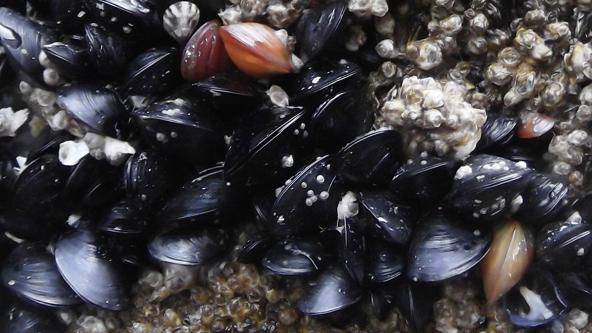By Jeff Rice
Puget Sound Institute
University of Washington
The opioid epidemic has now hit the waters of Puget Sound. State agencies tracking pollution levels in Puget Sound have discovered traces of oxycodone in the tissues of native bay mussels (Mytilus trossulus) from Seattle and Bremerton area harbors.
The mussels were part of the state’s Puget Sound Mussel Monitoring Program. Every two years, scientists at the Washington Department of Fish and Wildlife transplant uncontaminated mussels from an aquaculture source on Whidbey Island to various locations in Puget Sound to study pollution levels. Mussels, which are filter feeders, concentrate contaminants from the local marine environment into their tissues. After two to three months at the transplant site, scientists analyze the contaminants in the collected mussel tissues.
The areas where the oxycodone-tainted mussels were sampled are considered highly urbanized and are not near any commercial shellfish beds. “You wouldn’t want to collect (and eat) mussels from these urban bays,” explained PSI’s Andy James, who assisted with the study. The oxycodone was found in amounts thousands of times lower than a therapeutic dose for humans and would not be expected to affect the mussels, which likely don’t metabolize the drug, James said. The findings may raise concerns for fish, however, which are known to respond to opioids. Lab studies show that zebrafish will learn to dose themselves with opioids, and scientists say salmon and other Puget Sound fish might have a similar response.
Scientists typically find many chemical compounds in Puget Sound waters, ranging from pharmaceuticals to illicit drugs such as cocaine, but this is the first time that opioids have been discovered in local shellfish. The contaminants, in this case, are thought to be passed into Puget Sound through discharge from wastewater treatment plants. Even filtered wastewater can potentially include traces of thousands of chemicals known as contaminants of emerging concern. Runoff from agriculture and stormwater are also common sources of CECs.
In addition to oxycodone, the mussels also showed high levels of the chemotherapy drug Melphalan, which is a potential carcinogen due to its interactions with DNA. The drug was found at “levels where we might want to look at biological impacts,” said James. The mussels had ingested amounts of Melphalan relative by weight to a recommended dose for humans.
These Puget Sound mussel monitoring studies occur every two years and are currently funded by WDFW, the state’s Stormwater Action Monitoring program, and various other regional partners. The monitoring is led by Jennifer Lanksbury, of WDFW’s Toxics-focused Biological Observing System, along help from a host of citizen science volunteers from across Puget Sound. PSI’s Andy James worked with TBiOS on the chemical analysis and presented the findings at last month’s Salish Sea Ecosystem Conference.
James and his team at the University of Washington’s Center for Urban Waters in Tacoma are now using high-resolution mass spectrometry to look for additional chemical exposures in the mussel tissues and to evaluate potential biological impacts on Puget Sound species.
Read more about mussel monitoring in the Encyclopedia of Puget Sound.



